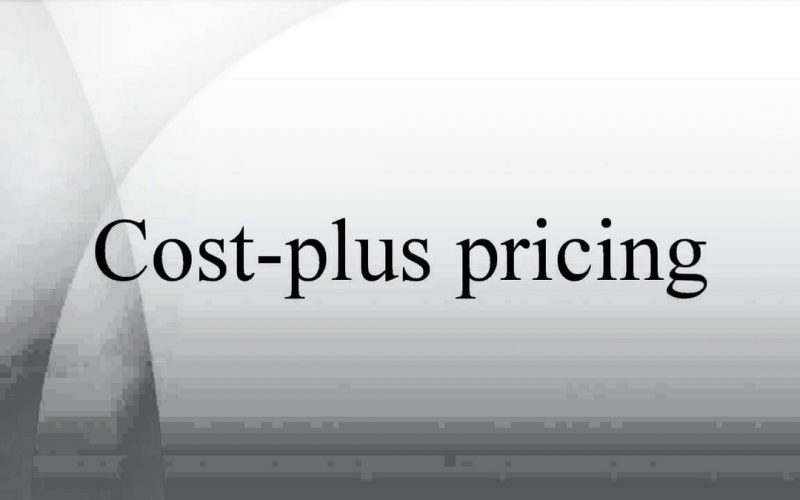Businessmen and women tend to add extra fees to goods due to expenses incurred before the goods reach his or her hand. We’ll be looking at what is cost-plus pricing, example, advantages, and disadvantages.
What is Cost plus pricing?
Cost-plus pricing entails attaching a charge to the cost of goods and services to determine the selling price. In this strategy, you add together the good’s direct cost of materials, direct labor, and overhead expenses, then add a markup % to get the price. Moreover, Cost-plus pricing can also be utilized in a client contract, where the customer compensates the seller for all costs spent and also pays an agreed profit in addition to the costs spent.
Cost Plus Pricing Analysis
This technique is not appropriate for deriving the cost of the product. That is to be put up for sale in a competitive industry. Primarily because it does not factor in the competitive pricing. Consequently, this method is likely to produce a significantly overpriced product. Furthermore, prices should be set on what the customers are willing to pay. Which might also result in a significantly different margin than the standard margin assigned using this pricing method.
Cost-plus pricing is a more useful resource in a contractual context because the provider has no potential losses. Nevertheless, be sure to evaluate which costs are authorize for recovery under the contract. Because It is feasible that there are restrictions in the terms of the agreement that the provider must exclude numerous costs from reimbursement, and so can possibly incur a loss.
Cost plus pricing Example
Below are cost-plus pricing example.
ABC International, as an example of cost-plus pricing. They design products with direct material costs of $20.00, direct labor costs of $5.50, and allocated overhead of $8.25. All of the firm’s items are marke up by a typical 30% markup.
Furthermore, ABC combines the prices together to get at a total cost of $33.75. And then multiplies this amount by (1 + 0.30) to arrive at the product price of $43.88.
Another example of CP pricing is when you manufacture a $15 product and want a 50% profit margin, so you sell it at $30. Businesses employ this cost-plus pricing.
Advantages of cost plus pricing
#1. It requires low resources: Advantages of cost plus pricing
Cost-plus pricing does not necessitate extensive market research. The cost of manufacturing is something that most organizations are aware of through adding up numerous invoices, labor costs, and so on. Furthermore, Businesses can then take the total costs and add a margin that they believe the market will bear. It’s rather straightforward, and as a result, it’s a common method among tiny organizations or those where other parts of production must take precedence.
#2. It offers complete expense coverage and a regular rate of return.
Advantages of CP pricing ensure that the complete cost of manufacturing the product or performing the service is covered. thereby allowing the mark-up to provide a positive rate of return as long as whoever calculates the expenses per user or item adds everything up accurately.
However, numerous additional costs are frequently unaccountable, resulting in lower margins. Businesses, fortunately, can construct a buffer against unanticipated expenditures and variations in demand by increasing the discretionary margin. Furthermore, because your rates remain inactive, you can simply forecast revenue for a particular month based on conversion history, marketing expenditure, and so on.
#3. It protects against a lack of knowledge.
Cost-plus pricing is very useful when you don’t know how much a consumer is willing to spend. And knowing there aren’t any direct competitors in the market. Basically, the only data you have to influence your pricing selection is the computation or estimation of your costs, which allows you to set at least a starting price from which to work as the market and customer evolve.
Cost plus pricing Disadvantages
#1. It’s a colossal waste of time: Cost plus pricing Disadvantages
The disadvantages of CP pricing are that the assurance of a target rate of return provides little motivation to lower costs or increase profitability through price differentiation. Stakeholders can quickly get complacent about price, encouraging carelessness and profit atrophy as the market and customer evolve. For context, the government employs this method of guaranteeing profit margins on costs to make contracts with private enterprises “easier.” As a result, there is an incentive to optimize expenses, resulting in billions of dollars in waste and substandard craftsmanship.
#2. It fosters a profit-loss isolationism culture.
This inward-looking strategy discourages market research. Though monitoring competition prices aren’t the be-all and end-all of pricing, it is quite significant. You should be aware of the price of competing goods because it can influence your own marketing and pricing strategy. Furthermore, without research, you have little to no information about your customers’ perceived worth of the product (more in the last point).
#3. It fails to consider consumers.
The most significant disadvantage of cost-plus pricing is that it completely disregards the client’s willingness to pay. A consumer must be in it, in order to make money. They are the most crucial aspect of selling anything, thus any pricing structure that ignores customer value creates a vacuum that drains all of the profit out of the business.
Moreover, to put it bluntly, clients don’t care how much anything costs you to produce. That is just the fact and truth. They recognize that there are costs associated with operating a business, but consumers are more concerned with the amount of value you provide. For instance, producing a bottle of Rogaine may cost $3, $10, or $50, yet customers only consider price in relation to the value of a husband with hair on his head, which may be 2x, 10x, or 100x the cost depending on follicular effectiveness. Merely pursuing a desired rate of return can result in diminishing demand that is ignored until significant losses occur. Even if customers are purchasing your product, there may be better pricing available for revenue optimization and price differentiation.
Cost-Plus Pricing Analysis
This approach is unsuitable for determining the price of a product to be sold in a competitive market. Owing to the fact that it does not take into account the prices charged by competitors. As a result, this strategy is likely to produce a significantly pricier product. Furthermore, prices should be established depending on what the market is willing to pay, which may result in a much different margin than the conventional margin assigned using this pricing strategy.
Because the provider has no downside risk, CP pricing is a more powerful tool in a contractual context. Nevertheless, make sure to verify which costs are authorized for reimbursement under the contract. Because it is possible that the contract’s provisions are so restricted that the provider must exclude several charges from reimbursement, potentially resulting in a loss.
What Is the Benefit of Cost-plus Pricing?
Without conducting extensive market research, it can help businesses set consistent prices for their goods and services. It might also be a solid technique for small organizations or companies with little free time to devote to complex pricing strategies.
What Is the Main Problem With Cost-plus Pricing?
It makes it far too simple to stop caring about your price after it has been decided. Does not relate to the value your product offers customers. provides little motivation to increase earnings through changes or revenue expansion. makes it challenging to adjust the pricing as necessary.
What Is the Difference Between Cost-plus Pricing and Target Pricing?
Cost-plus pricing and target costing are two distinct concepts. According to Accounting Tools, target costing is a management strategy used in product development to estimate manufacturing costs, and CP pricing is a system used to estimate the product’s selling price.
How Is Cost-plus Pricing Used by Businesses?
When a company uses CP pricing, it multiplies its cost of items sold by the desired markup percentage to determine prices. Simply multiply the cost of production by a predetermined percentage to determine your selling price.
How Does a Cost Plus Plan Work?
In a “cost plus” plan, the employer enters into a contract with an insurance company or trustee plan to provide indemnification for claims made by employees based on predetermined risks. The employer pledges to refund the plan or insurance carrier for the cost of such claims plus an administration fee.
Why Is Cost-plus Pricing Criticized?
Cost-plus pricing has frequently been applied to government contracts (also known as cost-plus contracts), but it has come under fire for decreasing suppliers’ incentives to manage direct costs, indirect costs, and fixed costs, whether or not they are connected to the creation and sale of the good or service.
What Exactly Does “Cost-plus 20%” Mean?
In accordance with the terms of the contract, the contractor may “pad” some costs, particularly labor wages, to account for overhead costs and unforeseen costs. There is no industry standard, although the “plus” portion of cost-plus contracts often ranges from 10% to 20% of the project’s overall cost.
Conclusion
Costs-plus pricing is the most basic approach to establishing price because it contains the fundamental idea of doing business.
Cost plus pricing FAQ
What does cost-plus pricing mean?
Cost-plus pricing is a method in which the selling price is set by evaluating all variable costs a company incurs and adding a markup percentage to establish the price.
What is cost-plus pricing example?
Cost Plus Pricing is a very simple pricing strategy where you decide how much extra you will charge for an item over the cost. For example, you may decide you want to sell pies for 10% more than the ingredients cost to make them. Your price would then be 110% of your cost.
How is cost plus pricing used at a reasonable price?
Cost-plus pricing involves adding a markup to the cost of goods and services to arrive at a selling price. Under this approach, you add together the direct material cost, direct labor cost, and overhead costs for a product, and add to it a markup percentage in order to derive the price of the product
- Cost-plus Pricing Strategies: Formula and Examples
- Pricing Strategy: Best strategies to Maximize profit
- eBay Selling Fees: Pricing, Calculators and Best UK Practices
- Sell Your Business: How To Sell Your Business & Ideas Online
- Selling Online: Beginner’s Guide To Buying and Selling Online
- Premium Pricing Strategy: Overview & Detailed Example






